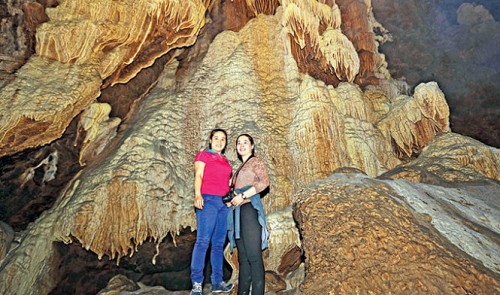New grotto on UNESCO-recognized karst plateau a promising tourist attraction
With access to a newly discovered grotto within the UNESCO-recognized Dong Van Karst Plateau Geopark being restricted to facilitate further study, the resplendent cave promises to become a touristy spot.
Lung Khuy Grotto, whose discovery was announced early this month, nestles inside an imposing mountain in Quan Ba District, located in Ha Giang Province.
The grotto is part of the Dong Van Karst Plateau Geopark, which spans four of the province’s districts, including Quan Ba, Yen Minh, Dong Van, and Meo Vac.
The Lung Khuy Grotto cave entrance is surrounded by a stone wall which has two carefully locked doors.
 |
| The newly discovered Lung Khuy Grotto in the UNESCO-recognized Dong Van Karst Plateau Geopark |
The cave is relatively wide, with certain sections measuring 50 meters in width.
Hanging from its ceiling are countless stalactites of various sizes and shapes.
Many are two or three meters long and boast bizarre shapes.
The cave is also adorned with drooping curtain-like stalactites, rugged dark-yellow stone pillars, and transparent, white stalactites.
As part of the Dong Van geopark, the Lung Khuy Grotto as well as other caves and stone forests in Quan Ba District’s rocky area are also rich in geological value.
With its pristine charms and geological and geomorphologic diversity, the Lung Khuy Grotto promises to emerge as a fascinating tourist destination.
The Dong Van Karst Plateau was recognized by the UNESCO’s Global Geoparks Network in 2010 as one of 77 geological parks in the world and the second in Southeast Asia, after the Langkawi Geopark in Malaysia.
Located at an altitude of 1,000m-1,600m, the plateau is one of the country’s unique limestone areas, which contains significant imprints of the development of the earth's crust.
Up to 80 percent of the plateau’s karst formations are limestone formed by the elements through different natural development stages.
At least 13 fossil-geological formations have been found on the Dong Van plateau.
Among them, Chang Pung, the oldest, dates back 545 million years, according to the Viet Nam Institute of Geosciences and Natural Resources.
(Source: Tuoitrenews)